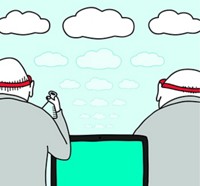Advertisement
Grab your lab coat. Let's get started
Welcome!
Welcome!
Create an account below to get 6 C&EN articles per month, receive newsletters and more - all free.
It seems this is your first time logging in online. Please enter the following information to continue.
As an ACS member you automatically get access to this site. All we need is few more details to create your reading experience.
Not you? Sign in with a different account.
Not you? Sign in with a different account.
ERROR 1
ERROR 1
ERROR 2
ERROR 2
ERROR 2
ERROR 2
ERROR 2
Password and Confirm password must match.
If you have an ACS member number, please enter it here so we can link this account to your membership. (optional)
ERROR 2
ACS values your privacy. By submitting your information, you are gaining access to C&EN and subscribing to our weekly newsletter. We use the information you provide to make your reading experience better, and we will never sell your data to third party members.
ACS News
The Data-Sharing Dilemma
Information technology executives confront tension in wiring the pharmaceutical lab
by Rick Mullin
April 29, 2013
| A version of this story appeared in
Volume 91, Issue 17

The chief information officer (CIO) panel discussion, always the centerpiece of the Bio-IT World Conference & Expo held each spring in Boston, had a fun feature this year: a little table with a whiskey bottle and shot glass for each of the six panelists. Kevin Davies, editor-in-chief of Bio-IT World magazine and the event’s moderator, warned that panelists would be made to take a shot every time they used the term “big data.”
Good thing there was only water in the bottle.
Call them what you want, but data in drug discovery are nothing if not big. Data represent the patient. They represent the drug, the cell, the experiment, and the clinical outcome. Data are the needle and the haystack. As such, information technology (IT) professionals at drug and biopharmaceutical firms shatter the socially isolated computer-geek stereotype. They are analytical gurus and rock-star scientists for the most part, and Bio-IT World, sponsored by the magazine and Cambridge Healthtech Institute, has for years been a celebration of their ascent to the highest levels of management.
But this year’s event seemed to highlight the familiar dimension of their profession—the IT manager as high-tech plumber. There was a lot of discussion about how to configure the computers. And a dominant theme was the growing tension between internal IT and external IT.
Frankly, much of what was presented threw cold water on the notion that an epoch of collaboration has dawned in the pharmaceutical sector. The talk of intramural cloud computing eclipsed that of the extramural. IT strategies, rather than parsing the big haystack, seemed at every point to be dividing the haystack into many proprietary stacks, a process that seems immensely counterproductive given the cliché’s notion of there being only one needle.
On the other hand, what is a CIO to do in the face of (pass the shot glass, please) big data. One must get one’s own house in order before reaching out to other houses, correct?
Panelist Remy Evard, CIO of the Novartis Institutes for Biomedical Research, noted that getting a handle on data is not so much a challenge of volume, but of determining value. Matthew Trunnell, CIO of the Broad Institute and another panelist, agreed that size matters less than structure and organization. “We have for a lot of our history focused on data generation,” he said. “Now the focus inside the Broad is on analysis, developing capabilities.”
But seated center stage, Andrea T. Norris, CIO of the National Institutes of Health, spoke of the need to look outside, which, in fairness, is a trend in research as drug companies place greater emphasis on partnerships. Norris noted that data-sharing policies have been written into the NIH grant process.
At a presentation titled “Science Information as a Business Asset,” John Koch, director of scientific information infrastructure at Merck & Co., described efforts under way to manage data within the walls of the laboratories at his company. The first order of business, he explained, has been defining the data of interest. “Understand: We are not trying to boil the ocean,” he said.
Koch said he is setting up IT support for finding, accessing, and structuring data and for breaking down silos within Merck. Asked whether creating such an IT-based research culture within Merck effectively establishes another silo, Koch pointed to a separate initiative at the company working on an outwardly directed IT infrastructure. In effect, yes, Koch is working in a silo because he has to. He acknowledged efforts under way in the drug industry to harmonize IT protocols and share data, “but frankly I haven’t seen any successes.”
Accelrys, Oracle, and Hewlett-Packard were among the IT system and software vendors on the Bio-IT World exhibit floor with product adaptations addressing collaborative data analysis.
Folks in the booths acknowledged the tension between proprietary and public infrastructure development. However, Etzard Stolte, chief technology officer of HP’s life sciences division, suggested that, as far as technology is concerned, the distinction between public and private computing clouds is artificial. The silo effect in research IT stems from traditional research culture. Haven’t scientists gotten over their problems with sharing in the past few years? “No,” Stolte said.
The CIO panel’s drinking game joke had run its course by the time NIH’s Norris mentioned her institute’s Big Data to Knowledge program, launched this year to promote the analytical skills necessary to meet the data analytics challenge in drug discovery. The entire panel, in fact, seemed to be “over” the size issue and much more concerned with the conversion of data to knowledge across all the little information worlds that are popping up, as one of the panelists noted, like mushrooms.
That image may have registered with the moderator, Davies, who promised that next year he will give the panel a new buzzword. And real liquor.
Views expressed on this page are those of the author and not necessarily those of ACS.





Join the conversation
Contact the reporter
Submit a Letter to the Editor for publication
Engage with us on Twitter